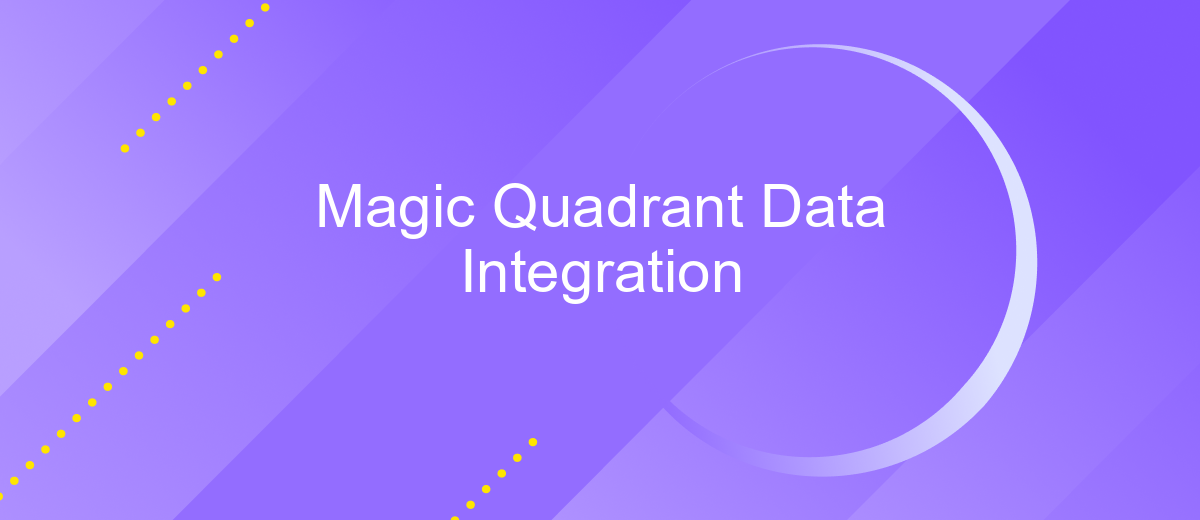Magic Quadrant Data Integration
The Magic Quadrant for Data Integration is an essential resource for organizations seeking to navigate the complex landscape of data integration solutions. This influential report evaluates and categorizes vendors based on their ability to execute and completeness of vision, offering valuable insights to help businesses make informed decisions and optimize their data management strategies. Discover the leaders, challengers, visionaries, and niche players shaping the future of data integration.
Introduction
In today's data-driven world, efficient data integration is crucial for businesses striving to maintain a competitive edge. The Magic Quadrant for Data Integration provides a comprehensive analysis of the leading tools and services in this domain, helping organizations make informed decisions. By understanding the strengths and weaknesses of various data integration solutions, companies can choose the best fit for their unique needs.
- Streamlined data management
- Enhanced data quality and consistency
- Improved decision-making capabilities
- Scalability and flexibility
- Cost efficiency
One of the noteworthy services in the data integration landscape is ApiX-Drive, which simplifies the process of connecting various applications and automating workflows. By using a user-friendly interface and offering a wide range of integrations, ApiX-Drive enables businesses to seamlessly synchronize data across platforms, ultimately enhancing operational efficiency and productivity. As organizations continue to prioritize data integration, leveraging tools like ApiX-Drive can provide a significant competitive advantage.
Evaluation Criteria

When evaluating data integration solutions, it is crucial to consider a range of criteria to ensure the chosen platform meets organizational needs. Key factors include scalability, ease of use, and the ability to handle diverse data sources. Scalability ensures that the solution can grow with your business, accommodating increasing volumes of data without compromising performance. Ease of use is essential for minimizing the learning curve and ensuring that both technical and non-technical users can efficiently leverage the platform. Additionally, the ability to integrate with a wide array of data sources, including cloud services, databases, and third-party applications, is vital for comprehensive data management.
Another important criterion is the platform's support for real-time data processing and synchronization. This capability is crucial for businesses that require up-to-the-minute information to make informed decisions. Furthermore, security and compliance features should not be overlooked, as data protection is paramount. Solutions like ApiX-Drive can be beneficial in this context, offering seamless integration capabilities and robust security measures. ApiX-Drive's user-friendly interface and extensive connector library make it a strong contender for businesses looking to streamline their data integration processes effectively.
Market Landscape

The data integration market is evolving rapidly, driven by the increasing need for seamless data flow across various platforms and applications. Organizations are prioritizing tools that offer robust integration capabilities, ensuring that data is accessible, reliable, and actionable. As businesses continue to embrace digital transformation, the demand for efficient data integration solutions is at an all-time high.
1. Scalability: Solutions must handle growing data volumes without compromising performance.
2. Flexibility: Support for diverse data sources and formats is essential.
3. User-Friendliness: Intuitive interfaces and easy setup processes are highly valued.
4. Security: Ensuring data privacy and compliance with regulations is critical.
5. Real-Time Processing: Immediate data synchronization is becoming a standard requirement.
ApiX-Drive is a notable player in this landscape, offering a user-friendly platform that simplifies the integration process. Its ability to connect various applications and automate data workflows makes it an attractive choice for businesses looking to streamline their operations. As the market continues to grow, tools like ApiX-Drive will play a crucial role in enabling efficient and effective data integration.
Vendor Profiles

In the ever-evolving landscape of data integration, vendors play a crucial role in providing the tools and technologies necessary for seamless data management. Each vendor offers unique capabilities that cater to different business needs, ensuring that organizations can efficiently handle their data integration processes.
Among the prominent vendors, ApiX-Drive stands out with its versatile and user-friendly platform. ApiX-Drive specializes in automating data integration tasks, allowing businesses to connect various applications and services without extensive coding knowledge. This capability significantly reduces the time and effort required for data synchronization.
- Comprehensive integration with numerous applications
- User-friendly interface for easy setup and management
- Automated workflows to enhance productivity
- Robust security measures to protect data integrity
Other notable vendors in the market include Informatica, Talend, and Microsoft, each offering a range of features tailored to different integration needs. By evaluating the strengths and capabilities of these vendors, organizations can choose the most suitable solution to streamline their data integration processes and achieve operational efficiency.


Key Trends and Recommendations
In the evolving landscape of data integration, several key trends are shaping the industry. The rise of cloud-based solutions continues to dominate, with organizations increasingly adopting hybrid and multi-cloud strategies to enhance flexibility and scalability. Additionally, the demand for real-time data integration is growing, driven by the need for instant insights and decision-making capabilities. Artificial intelligence and machine learning are also playing a crucial role, automating complex processes and improving data accuracy.
For organizations looking to stay ahead, it is essential to invest in robust integration platforms that offer seamless connectivity and support a wide range of data sources. Services like ApiX-Drive are becoming indispensable, providing user-friendly tools to automate workflows and integrate applications without the need for extensive coding. Prioritizing security and compliance is also critical, ensuring that data is protected and regulations are met. By focusing on these trends and leveraging advanced integration solutions, businesses can achieve greater efficiency and drive innovation.
FAQ
What is the Magic Quadrant for Data Integration?
How are vendors evaluated in the Magic Quadrant for Data Integration?
What are the key benefits of using a data integration tool?
How can I implement data integration in my organization?
What considerations should I keep in mind when selecting a data integration tool?
Time is the most valuable resource for business today. Almost half of it is wasted on routine tasks. Your employees are constantly forced to perform monotonous tasks that are difficult to classify as important and specialized. You can leave everything as it is by hiring additional employees, or you can automate most of the business processes using the ApiX-Drive online connector to get rid of unnecessary time and money expenses once and for all. The choice is yours!

